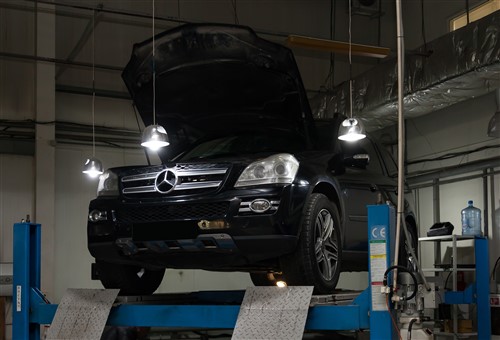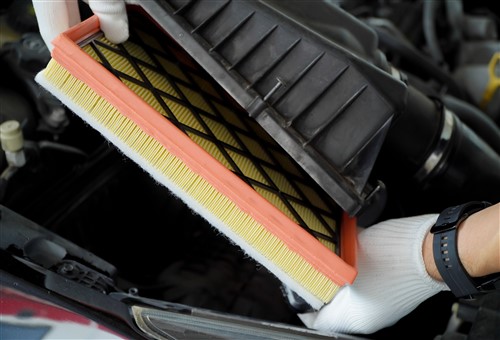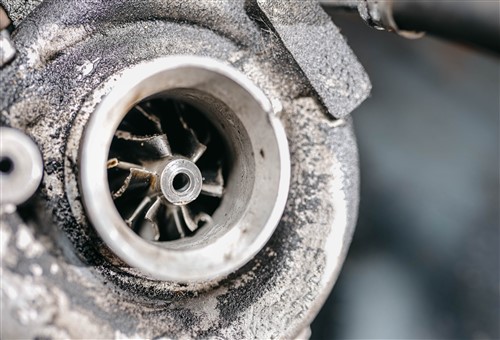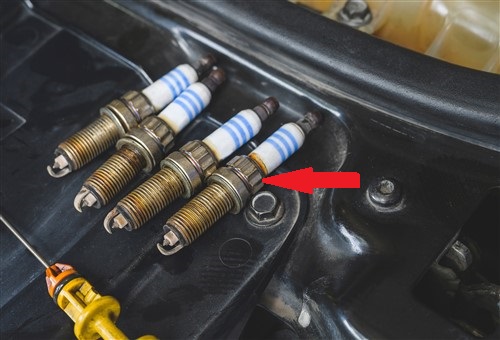
In Part 1 of this two-part article, we looked at how a simple oil change can go wrong on some Mercedes engines. Now, in Part 2, we will discuss how and why some other seemingly simple service and maintenance procedures can go equally wrong very quickly if you are servicing unfamiliar modern Mercedes vehicles. Let us start with-

The first thing to be aware of when you are servicing late-model Mercedes vehicles is that there are several very good reasons why OEM service information stresses the point that we should NOT replace OEM engine air filters with even the best aftermarket air filters.
Arguably, the most pertinent reason for this injunction is that, unlike on lesser vehicles, the air intake systems on modern Mercedes vehicles are precisely calibrated to allow for two things. The first is to allow the best possible airflow through the intake system, and the second is that modern Mercedes intake systems are designed to reduce if not always to eliminate oscillating pressure waves in the intake manifold plenum and runners.
Therefore, Mercedes OEM air filters are designed and constructed to offer as little resistance to air flowing through them as possible since the fuel and air metering systems on all modern Mercedes vehicles are incredibly sensitive to intake air mass and intake airflow issues. This is particularly true of forced induction engines because the additional components like charge pipes and intercoolers greatly increase the volume of the air intake system.
It could be argued that the same is true for all forced induction engines, but in the case of air and fuel metering systems on modern Mercedes vehicles, the system takes account of the braking effect a larger volume has on the airflow rate at some points in the intake ducting. One way that Mercedes does this on their V-type engines is to combine the output signals of the two MAF sensors to produce a single signal. The practical effect of this is that the fuel delivery system can compensate for much of the effect of MAF sensor drift or the loss of sensitivity in one MAF sensor.
Thus, in practice, all adaptations to the fuel trims affect all cylinders equally, because the fuel delivery system “sees” only one MAF sensor signal, which all but eliminates air/fuel mixture issues (and excessive fuel trim values) on a single bank of cylinders.
Given the above, it should be clear that installing an aftermarket air filter could create a significant restriction in the air intake system and could (and almost always does) cause fuel consumption, performance, and serious drivability issues and complaints, which brings us to the question of-
Removing and installing a new air filter element on many modern Mercedes models is often not as easy as it sounds. More often than not, it is necessary to remove several sections of intake ducting on forced induction engines just to get to the air filter box, so one particular area of concern is the thick rubber seals between sections of the intake ducting.
The main problem with these seals is that they are not as tough and resistant to damage as they perhaps might have been and it is in fact, very easy to damage one or more of these seals when we replace an air filter element on a modern Mercedes. Consider the image below-

This image shows the type of damage that can occur to a turbocharger when it ingests a piece of an intake ducting seal. In many cases, you cannot see if a seal is seated correctly when you assemble the intake ducting, meaning that it is often easy to pinch or break an already hardened seal when you assemble an intake system by feel alone.
In the case of the damaged turbocharger shown above, an inexperienced mechanic used brute force to fit two sections of plastic intake ducting together when the two pieces would not slide smoothly into each other. As a result of using brute force, the sharp edge of one piece of ducting cut through the seal in two places, and it was therefore inevitable that the piece of seal would cause fatal damage to the compressor wheel when it broke free, and the turbocharger ingested it. Although this particular turbocharger could be rebuilt relatively cheaply, you might not be so lucky because in some cases, intake duct seals cause irreparable damage to turbochargers when they are ingested.
So, the moral of this story is this: take extreme care when you assemble the intake system on any late-model Mercedes vehicle with forced induction and never reuse intake system seals if they show any evidence of having been pinched or cut- no matter how slight the damage seems to be. In fact, the best thing to do is to replace all intake system seals if you've disturbed them in any way and to use a light application of rubber grease on all seals to make assembly of the intake system easier. You will thank yourself later on that you went to the extra trouble, which brings us to the topic of-
We have all replaced thousands of spark plugs during our careers, and for the most part, this simple procedure does not present even the most inexperienced among us with undue difficulties. However, replacing spark plugs on some late-model Mercedes vehicles is altogether a different kettle of fish, not only because you need a special Mercedes engine-specific spark plug socket to do it but also because it is often impossible to remove the spark plug boots from the plugs without damaging the boots. Consider the image below-

Although many vehicles other than Mercedes use 12-point spark plugs (indicated by the red arrow) like the examples shown here, the problem with some Mercedes engines like the 3.5L V6 engine (276.957) is that standard thick-walled 12-point spark plug sockets typically do not fit into the recesses where the spark plugs sit. As a point of interest, note that replacing the sparkplugs on 3.5 V6 engines fitted to 350 GLA models has a recommended time of 2.7 hours- as per OEM service information because of the requirement to remove the air cleaner assembly and engine control module to gain access to the plugs.
Therefore, you need a special 14mm thin-walled spark plug socket (Mercedes part number W278 589 00 09 00). Using any other tool to remove the spark plugs could, and frequently does, cause the incorrect tool to break spark plug(s) or to become lodged in the cylinder head and in some cases, it may be impossible to remove the tool without going to great amounts of trouble and wasting valuable time.
It is perhaps worth pointing out that previous almost-universal 150 000+ km sparkplug replacement intervals no longer apply to almost all modern Mercedes engines. During the last few years, Mercedes has reduced sparkplug replacement intervals to fewer than 100,000 km on some engines and to 60 000 to 80 000 km for a few high-performance engines, which brings us to
It is not exactly clear why the boots that fit over the sparkplugs become almost fused to the porcelain part of the plugs in most petrol Mercedes engines, but the fact is that using too much force to dislodge the boots can break the boots or cause the boot to break off right at the ignition coil.
To address this problem, Mercedes now includes a note in service information to apply a small amount of plug connector grease (Mercedes part number A 002 989 80 51 09) to the inside of each connector/boot to assist with pushing the connector over the new spark plug. More importantly, though, the grease will prevent the connectors from becoming fused to the sparkplugs during the sparkplug replacement interval, making it a whole lot easier to remove the coils the next time you see the vehicle, which leaves us with this-
There is, of course, much more to servicing and maintaining modern Mercedes vehicles than the few points we discussed in this article, but we hope that this short introduction to the topic will illustrate the crucial need to consult OEM service information every time you encounter a late-model Mercedes vehicle.
One excellent source of Mercedes TSBs is available here but note that you must create a free account to access the extensive library of curated technical service bulletins that address almost every conceivable pattern failure on both new and older Mercedes vehicles. We do realise that not every problem on Mercedes vehicles is covered by a TSB but Mercedes is nothing if not thorough, so you will almost certainly find TSBs relating to relatively simple service procedures by using the resources' search tool to make it easier to find what you are looking for.
Here is a final thought: there is no need to be afraid to work on late-model Mercedes vehicles if you arm yourself with as much relevant OEM service information as you can. Mercedes vehicles, even new ones, are just cars after all, but it is nevertheless important to remember that new Mercedes vehicles are just a tad more complicated than most other new vehicles, so just be sure to be careful of what you don’t know about them.